What to Expect from a B2B SaaS Content Promotion Program
Last updated: February 18th, 2025
Many SaaS companies we talk to have tried digital PR strategies without success. They spend thousands of dollars on link-building campaigns and receive only a few links that barely improve rankings.
However, content promotion does work – you probably just need a different approach and strategy.
To help your content earn more high-quality traffic, we’ll discuss how to successfully collaborate with a marketing agency and the key differences between an average content promotion strategy and the top performing content promotion strategies.
Do you need help with your content promotion strategy? Reach out today to get your Free Marketing Plan.
How AI Has Impacted The Content Marketing Landscape (And The Role of Content Promotion)
Several years ago, writing a helpful, comprehensive blog post on a subject was sufficient to rank for the intended keyword.
Yet you’ve probably noticed that simply improving the quality of a blog post is no longer a sufficient strategy to rise in the rankings.
This is largely because AI tools have made it relatively easy to generate comprehensive blog posts with minimal effort. As a result, the SERPs are flooded with extensive content for any given keyword, and improving the content’s quality beyond a specific threshold delivers diminishing returns from a rankings perspective.
In addition, plenty of AI tools make it easy for anyone to quickly optimize a piece of content for SEO, so most of your competitors probably have decent SEO.
With so many decent quality blog posts to choose from, search engines are becoming increasingly reliant on authority metrics (like backlinks) to determine which brands are reputable and provide genuine expertise on a subject.
Even if you have an outstanding piece of content on a subject, search engines will likely rank a decent piece of content produced by a higher authority website ahead of yours.
As a result, website authority is more important than ever before, and we’re prioritizing content promotion to help our clients remain relevant in the search results.
Is Content Promotion The Right Solution?
This is a valid question, as applying an effective solution to the wrong problem will not improve growth.
Here are the most common challenges that we typically use content promotion to solve:
- You have high quality, SEO-optimized content on the website, but it isn’t ranking in the top three spots for the target keyword (or not even on page 1 of Google).
- You have a low-authority website, and the primary pages aren’t ranking for core keywords.
- You have a high authority website, but you’re competing with even stronger websites and for very competitive keywords.
However, your content promotion strategy won’t work if your content isn’t converting. Before implementing a content promotion strategy, there are some prerequisites we check to ensure the content itself is:
- High quality
- Well optimized for SEO
- Attracting the right prospects
If your content is low quality, it will be much more difficult to earn links from reputable websites. Even if you do manage to earn links to those pages, sending qualified traffic to low quality content will likely create a negative impression of your brand with prospects, and you’ll see low conversion rates from your content.
Content Promotion Partnership Mistakes To Avoid
While it’s your marketing agency’s responsibility to produce results that drive revenue for your business, there are a few mistakes we often see clients make that can hinder the success of the content promotion strategy.
Here are the top mistakes to avoid to ensure the marketing agency can deliver the results you’re paying for.
Expecting Instant Results
All organic marketing strategies take time to generate an ROI, and content promotion is no different.
In fact, there are a few reasons why it’s a red flag if a marketing agency promises instant content promotion results:
- They aren’t allocating time to establish processes, meaning they’re likely using a random collection of hacks and tactics without any real strategy.
- They aren’t allowing for time to iteratively test different approaches to identify what works for your target audience and maximize results.
- They may be earning low-quality links from link farms that don’t drive real results (and can actually hurt your brand in the long run).
However, we also realize it’s risky to blindly trust that your agency is doing a good job and will eventually produce results.
That’s why we create forecasts for each of our clients, and they can track small wins and KPIs as we build out the strategy.
They should also be able to explain their content strategy and have proven systems and processes that generate consistent results.
Poor Communication
Another key reason many digital PR collaborations fail is because the client and marketing agency have poor communication.
Understanding the market and target audience is key to any successful marketing strategy. As marketing agencies don’t know your audience and market as well as you do, you’re setting them up for failure if you don’t work with them to fill these knowledge gaps.
Therefore, each marketing campaign we run at Powered By Search is a collaborative effort with our clients.
While we have the expertise and experience for running marketing campaigns, we’ve found that our most successful engagements are with communicative clients who provide input when necessary.
Chasing Shiny Objects
Finally, you’ll probably hear about plenty of new tactics at conferences and events, and while it might be tempting to try them out, deviating from the initial strategy laid out will only hinder your growth in the long run.
Constantly changing tactics makes it difficult to iteratively test and identify what works, and without testing, you can’t improve your strategy.
Additionally, a core part of our predictable growth methodology is building a flywheel that produces compounding results. If you’re always changing tactics, you won’t have a solid foundation that you can use to build out the rest of your marketing strategy.
The 3 Key Pillars of Our B2B SaaS Content Promotion Strategy
Supporting your marketing agency is essential for a successful collaboration, but the marketing agency must also have a proven system that consistently delivers excellent results.
Here at Powered By Search, we have an entire team dedicated exclusively to content promotion, and below we’ll discuss the exact strategy we use to generate long-term results.
This strategy can be broken down into three categories:
- Strategy: Identify the right content to promote
- Plan: Identify the quantity and types of links to build
- Process: Use a proven outreach strategy
Strategy: Identify The Right Content To Promote
Many content promotion strategies focus on driving links to the homepage, which can help incrementally increase the authority of your website’s domain.
However, this isn’t the most impactful link-building strategy, as the page receiving the link will receive the most direct benefit.
The first step in our process is identifying the best pages to promote. To answer this question, we look at two factors:
- The page’s value: We prioritize pages and blog posts that produce the most high-value sales.
- Ranking improvement potential: We also prioritize blog posts and pages that are already on the first or second page and have a good chance of rising in the search results based on the competitiveness of the top ranking pages’ backlink profiles.
From a tactical perspective, here’s the three-step process we use to identify the best pages to promote.
Step 1: Identify The Website’s Keyword Difficulty Baseline
First, we create a keyword difficulty (KD) baseline for each client’s website. This metric is different from the keyword difficulty score provided by third-party SEO tools like Ahrefs and SEMrush because it measures how difficult it is for that particular website to rank for a specific keyword.
To determine the KD baseline metric, we export the top ranking keywords (those in the top three positions in the SERPs), remove falsifying keywords (brand terms, etc.), and assign keyword difficulty buckets based on frequency in charts.
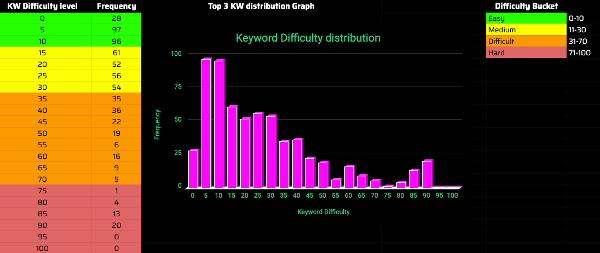
Weaker site
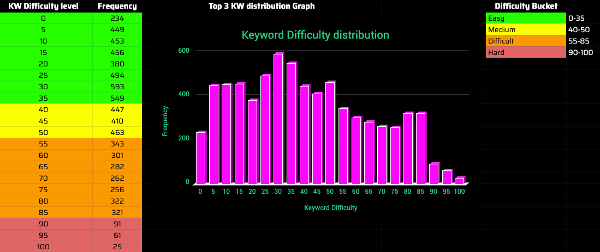
Stronger site
Step 2: Identify Quick Win Pages To Promote
Once we have a keyword difficulty baseline, the next step is identifying the pages to promote, considering both the page’s value and ranking improvement potential. Here’s how we identify these pages:
- Export “quick win” pages (4-20)
- Remove non-relevant keywords
- Add KD buckets and conversion data to determine the value of that page
- Shortlist important pages/keywords
Step 3: Deep Dive Analysis of Each Page
Before adding these pages to our list to promote, the final step is checking that the blog post can improve based on its current status.
- Check for content type match: Is Google showing a blog post for the desired keyword? If we have a blog post, but it’s only showing homepages, sending links to our blog post won’t help increase its rankings.
- Check for search intent match: If we have a guide or “how-to” blog post, but the searcher is looking for a list of different vendors, sending more links to our guide won’t help it rank for that keyword.
- Visual content quality check and run a content audit: Before sending links to a blog post, we want to make sure it’s high quality and reflects the client’s current philosophies and offerings.
Finally, we prioritize blog posts to promote based on their highest value (most conversions) and likelihood of improvement.
Plan: Identify The Quantity and Types of Links Required
Many content promotion programs fail because marketers don’t build enough quality links to a specific page.
For example, we prioritize boosting pages with high conversion rates even though many of these pages compete for relatively high difficulty keywords. It may require five or six high-quality links rather than just two or three to outrank the current blog posts dominating the SERPs.
Unfortunately, if you stop after two or three links, you may find that the blog post doesn’t climb the rankings at all, yielding little to no ROI for your efforts. So giving up too soon is a key reason link building efforts often fail.
The type and quality of links you build is equally important. Most marketers consider domain authority when evaluating link partnership opportunities, though this is a relatively narrow metric that can be easily skewed by link farms and doesn’t always accurately reflect the real value of a link.
Additionally, various other factors influence the value of a link, including the individual page’s authority and traffic, as well as the topical relevancy of that website and the individual page.
Link placement (e.g., organically referenced within the text of the blog post rather than in the website footer) also significantly impacts a link’s value.
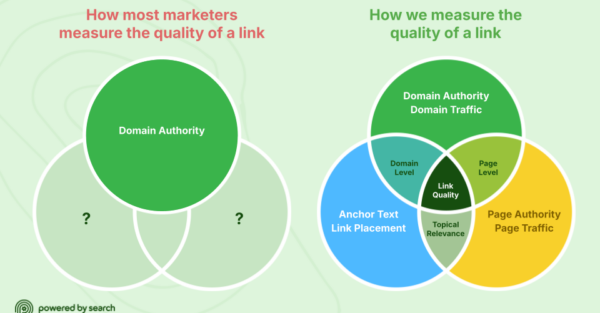
Therefore, to ensure we’re sending enough of the right links to the blog post to achieve the intended results, here’s how we identify and execute this second phase of our content promotion strategy.
Step 1: Identify The Link Gap
During this phase, we look at how many links are required to achieve the intended result.
This calculation answers the following questions:
- Calculate the number of referring domains needed to close the gap: Based on the other top-ranking pages in the SERPs, this is the number of links needed to achieve the desired result.
- Calculate the link velocity gap: This considers how many links the competitors are earning to these pages each month, as link metrics are rarely stagnant.
- Campaign duration: How much time will be required to build the required links to close the gap.
- Calculate the Cost Per Link: This is the total cost, including labor, to earn each link.
Here’s an example of what our link gap analysis looks like:

Link Gap analysis
Step 2: Determine Link Type
Rather than exclusively considering the domain authority of the competition’s backlink strength, we also consider these metrics to accurately evaluate the quality of a potential link partner’s website:
- Domain Rating of both the domain and specific pages of the potential link partner’s website.
- Traffic of both the domain and page
- Follow/No follow ratio of links on the website (we typically only build follow links)
- Anchor text distribution: We look at exact match (matches the desired keyword we want to rank for), brand match, partial match (part of the keyword), and URL.
Here’s an overview of the link profile analysis on a domain level:

Domain-level link profile analysis
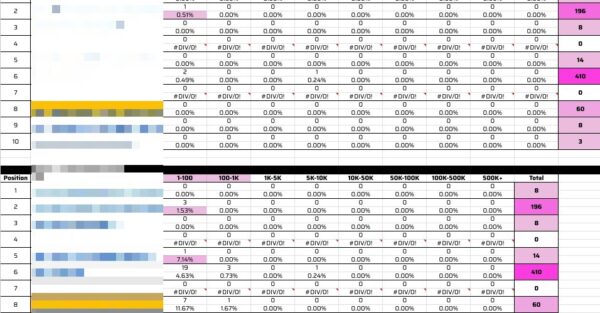
Page-level link profile analysis
Not all links are equally valuable, and some can even harm your brand.
Many marketing agencies use domain authority (sometimes referred to as “domain rating”) as a metric to measure link quality.
Yet domain authority isn’t a sufficient metric as some low quality websites that exist specifically to sell links (often referred to as “link farms”) have figured out how to game the system. While they may have a high domain authority or rating, these websites aren’t necessarily credible or relevant. Therefore, earning a link from them won’t help increase your website’s authority.
There are also two other factors that impact a link’s value:
- Topical relevance: If you have a SaaS product in the healthcare sector, a link from a website like Hopkins Medicine will be much more impactful than a link from Tripadvisor because Hopkins Medicine is related to healthcare.
- Traffic: Even if the linking domain is high quality and has a lot of traffic, the link will be less impactful if the specific page that links to your website has no traffic. Ideally, you want the page linking to your website to have high quality, relevant traffic.
To ensure the links we’re building provide maximum impact, our website evaluation criteria considers not just the domain’s authority, but also topical relevancy, the authority of the specific page we’re targeting, and whether the link will be follow or no follow.
Here’s the tactical step-by-step process we use to qualify a potential link partner.
Finally, we also consider the topical relevance of a potential link partner. For example, if we’re working with a client in the cybersecurity space, a small blog with high-quality content on cybersecurity is often a better link partner than a large generic website that earns a lot of traffic unrelated to cybersecurity.
Process: Using A Proven Outreach System
Not every person you contact for a link will say yes, so the more people you reach out to, the more links you’ll likely earn.
However, sending thousands of generic emails daily to earn a handful of links can be disastrous for your brand’s reputation, as some people will likely mark your emails as spam.
The good news is that if you make a few small adjustments to your outreach campaign, you can significantly increase your response rate.
At Powered By Search, we have a five-step proven outreach system that allows us to consistently earn above-average response rates:
- Strategy
- Prospecting
- Inspection
- Personalization
- Email Outreach
Step 1: Strategy
You’re much more likely to receive a positive response from a potential link partner if your outreach email can demonstrate why linking to your page provides significant value to them.
Therefore, here is the list of questions we ask before reaching out to a potential link partner:
- What kind of page would link to my page? What topic? For example, a blog post on common cybersecurity issues might link to an in-depth guide on a specific cybersecurity topic mentioned in the post.
- Why would they link to my page? The most common reasons someone might link to your blog post is if it provides a more helpful/in-depth explanation of a topic briefly mentioned in their post or a unique perspective on that topic.
Step 2: Prospecting
Next, we make sure the potential link partner meets specific quality criteria:
- DR20+
- Domain traffic 5000+
- Page traffic 1+
- Some keyword rankings for the page
We also look at topical relevance and whether the links are follow or no-follow from the link analysis report.
Step 3: Inspection
Once a website passes the initial prospecting stage, we manually review it and ask these questions:
- Is it a legit website/company?
- Is it active?
- Is the content good, informative?
- Can we get a link above the fold?
Step 4: Personalization
The average link building email outreach response rate is very low, and one reason for this is that most messages are never even opened by the right person. Even if the person does open the message, most are ignored because they are not incentivized to link to your content.
Instead, this is the three question system we use before sending a message:
- Who is the best possible point of contact? (Writer, editor, marketer, owner, etc.)
- What is the best medium to contact them at? (Email, LinkedIn, Twitter, etc.)
- What is the value proposition that would make it beneficial for them to link to us?
Step 5: Email Outreach
We use dynamic personalization to make each message relevant to the recipient.
This process ensures that your brand always appears professional and courteous. However, we still set up alternative email domains (e.g., “.co”) so that your brand won’t be affected in the off-chance that someone marks the email as spam.
Our email:
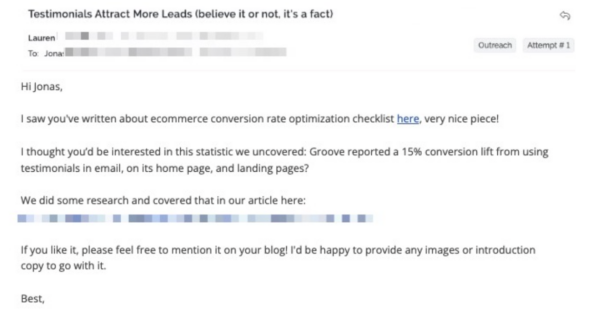
The reply:
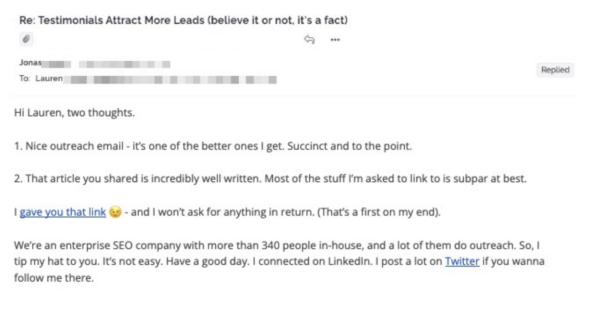
Here are some additional tips for writing a great outreach email:
- Peak their interest
- Avoid fake flattery
- Showcase the efforts you put in
- Use your “why”
- Use the right tone of voice
- Be funny/stand out (when it make sense)
- Always follow up (at least twice)
Results From This Content Promotion System
While this strategy may seem promising, the real question is; does it actually work?
We implemented it for UpLead and it helped them increase their web traffic by 1,400%.
When they first approached our team, UpLead had a small library of quality content, but they needed a boost in the search results to increase rankings, and ultimately, traffic.
Rather than earning random links to random pages, we implemented our strategic approach by first identifying one specific page that was already driving plenty of sales.
For the next two months, we focused all of our efforts on driving more links that met our specified criteria to that top article.
Over the course of the partnership, UpLead earned over 300 backlinks to its content, which significantly increased its domain rating and aided their top-of-funnel marketing and sales efforts:
- Organic web traffic increased by 1,400%
- Free trial sign-ups increased by 213%
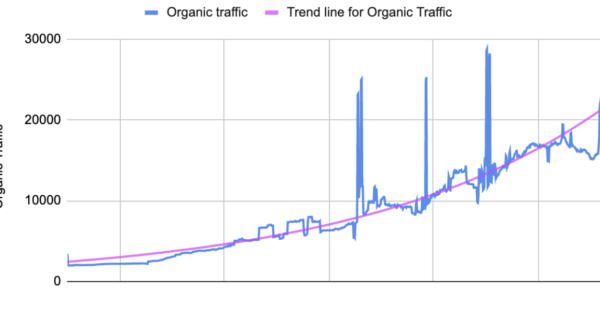
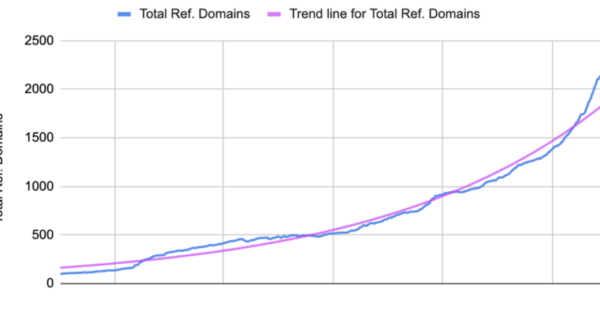
When Should You Start Your B2B Content Promotion Program?
Content promotion is often an afterthought, but you’re wasting money if the content isn’t getting traction. Unfortunately, producing quality content isn’t enough to rank first on Google in today’s competitive content marketing landscape.
Additionally, it may take months for the impact of links to pay off and boost your content in the search results, so it’s better to start sooner rather than later.
If you want a team of experienced marketing professionals that consistently help SaaS companies earn more traffic to their existing content, contact Powered By Search today. The first step is a free consultation where we’ll identify low-hanging fruit and map out a long-term strategy.
If you want a team of experienced marketing professionals that consistently help SaaS companies earn more traffic to their existing content, contact Powered By Search today. The first step is a free consultation where we’ll identify low-hanging fruit and map out a long-term strategy.
Reach out to us today for your Free Marketing Plan to boost your content with a promotion program.
What you should do now
Whenever you’re ready…here are 4 ways we can help you grow your B2B software or technology business:
- Claim your Free Marketing Plan. If you’d like to work with us to turn your website into your best demo and trial acquisition platform, claim your FREE Marketing Plan. One of our growth experts will understand your current demand generation situation, and then suggest practical digital marketing strategies to hit your pipeline targets with certainty and predictability.
- If you’d like to learn the exact demand strategies we use for free, go to our blog or visit our resources section, where you can download guides, calculators, and templates we use for our most successful clients.
- If you’d like to work with other experts on our team or learn why we have off the charts team member satisfaction score, then see our Careers page.
- If you know another marketer who’d enjoy reading this page, share it with them via email, Linkedin, Twitter, or Facebook.